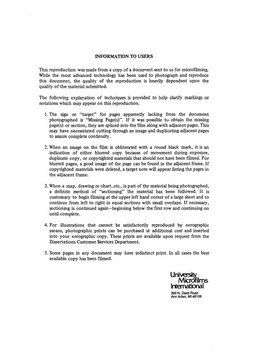Dependency formations and the Spanish-American community :
| dc.contributor.author | Williams, Gerry C., | en_US |
| dc.date.accessioned | 2013-08-16T12:29:21Z | |
| dc.date.available | 2013-08-16T12:29:21Z | |
| dc.date.issued | 1985 | en_US |
| dc.identifier.uri | https://hdl.handle.net/11244/5334 | |
| dc.description.abstract | A detailed history of the factors which affected and changed this region is presented. Utilizing government documents, business records, case studies, and published works, data was collected on the period from the mid-1600's to the late 1940's. Special emphasis was placed on gaining an historical perspective to the colonization of the region by the Spanish and their subsequent relationships with the native populations. Data is also presented on the natural environment, pre-1840's population trends, economic structures, and the socio-cultural characteristics of the Spanish population. The nineteenth century is viewed from the perspective of the conquest of the region by the United States and the subsequent establishment of a foreign social order. Materials on the United States expansion and the status of the Spanish population under United States territorial rule are discussed at length. Special attention is given here to the economy, demographic patterns, land ownership transformations, wage labor formations, and the political order. Data on the twentieth century focuses on the more specific impact of economic dependency and exploitation at the local village level. Ten case studies including the villages of Guadalupe, Sandoval, Alameda, Concho, Villanueva, Dona Ana, Placitos, Manzano, San Jose, and El Cerrito are presented as illustrations of this general pattern. | en_US |
| dc.description.abstract | This study is concerned with the factors which underlie the economic development of New Mexico with particular reference to the Spanish population and the period of United States expansion and colonization of this region. A model based upon a world-system approach and dependency formation is developed. It is argued that the development of a class structure, in which the majority of the Spanish population were found at the lower end, came as a result of their participation in what has been termed a modernization process. The analysis suggests that since the sixteenth century New Mexico has been part of a larger system of worldwide economic relationships and it is only within this context that we can interpret and understand the nature of the growth and development of this region. | en_US |
| dc.format.extent | ix, 346 leaves : | en_US |
| dc.publisher | The University of Oklahoma. | en_US |
| dc.subject | Hispanic Americans New Mexico. | en_US |
| dc.subject | Anthropology, Cultural. | en_US |
| dc.title | Dependency formations and the Spanish-American community : | en_US |
| dc.type | Thesis | en_US |
| dc.thesis.degree | Ph.D. | en_US |
| dc.note | Source: Dissertation Abstracts International, Volume: 46-06, Section: A, page: 1676. | en_US |
| ou.identifier | (UMI)AAI8518307 | en_US |
| ou.group | College of Arts and Sciences::Department of Anthropology |
Files in this item
This item appears in the following Collection(s)
-
OU - Dissertations [9427]
